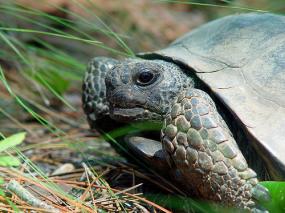
The plant is situated in the Mojave Desert — an ideal spot for generating solar power, but also prime habitat for the desert tortoise. To keep the installation from being derailed, investors have allocated $56 million — and have already spent more than $130,000 per animal — to care for and relocate the species.
The private sector is not the only one footing the bill to keep this reptile burrowing beneath the southwest. Among critters protected by the act, the tortoise is one of the top recipients of tax dollars, which have been funneled through four states, seven military installations and four national parks with little success in advancing conservation goals. The U.S. Fish and Wildlife Service reports that the tortoise received nearly $190 million in tax-dollar support from 1996 to 2009, yet species population increased negligibly.
The power plant itself received $1.6 billion in taxpayer-backed loan guarantees to help create green jobs and energy. In short, tax dollars appear to have been ineffective in protecting this species, and its latest risk comes from a government-supported project. At the end of the day, we may have no tortoise, no green power, and no money!
The Endangered Species Act is expensive and ineffective in its reactive approach to conservation, which tends to penalize property owners once a species is already in a tailspin. A system of positive incentives for environmental stewardship, before formal listing under the ESA, could enhance species conservation by motivating more effective and less expensive habitat management.
“Candidate conservation banking” is an incentive-based approach for soon-to-be rare species, such as the eastern gopher tortoise. This species waits on the “candidate” list, which equates to regulatory limbo — the species is imperiled, yet receives no legal protection. But hanging out on the B list might be a good thing.
Under this model, private landowners who voluntarily conserve habitat on their property receive “credits” — a unit of trade that places monetary value on conservation measures — that can be sold in the marketplace. The number of credits on a parcel of land is determined via a science-based method to ensure a net conservation benefit for the animal when used as offsets by buyers for future impacts, such as removing ground cover or accidentally crushing a tortoise while installing a solar power plant. In exchange for alleviating potential impacts, buyers would receive regulatory predictability from the U.S. Fish and Wildlife Service if the species becomes officially “threatened” or “endangered.” Indeed, the Fish and Wildlife Service issued a notice of proposed rule-making to support such assurances.
Conservation partners including World Resources Institute and Advanced Conservation Strategies are working on a pilot project with the army to promote increased gopher tortoise management on private lands to help preclude the need to list the gopher tortoise, which could mean a loss of public training areas.
This model, as outlined in a recent report from the Conservation Leadership Council, can be replicated in other regions dealing with candidate species such as the lesser prairie chicken in Texas and greater sage-grouse across the West.
Candidate conservation banking represents a promising development of voluntary exchange through a market-like approach. This path can mobilize environmental stewardship on private and public lands, help imperiled species and keep money in our pocketbooks.


